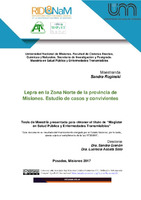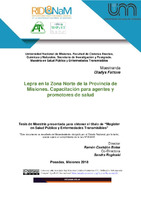| dc.rights.license | Licencia de Creative Commons Reconocimiento-NoComercial-CompartirIgual 4.0 Internacional (CC BY-NC-SA 4.0) | |
| dc.contributor | Grenón, Sandra Liliana | |
| dc.contributor | Acosta Soto, Lucrecia | |
| dc.creator | Roginski, Sandra | |
| dc.date.accessioned | 2020-10-29T02:32:28Z | |
| dc.date.available | 2020-10-29T02:32:28Z | |
| dc.date.issued | 2017-12-01 | |
| dc.identifier.citation | Universidad Nacional de Misiones. Facultad de Ciencias Exactas, Químicas y Naturales. Módulo de Bioquímica y Farmacia. Secretaría de Investigación y Postgrado. Maestría en Salud Pública y Enfermedades Transmisibles (2017). Lepra en la Zona Norte de la provincia de Misiones. Estudio de casos y convivientes (Tesis de Maestría) / Directoras, Dra. Sandra Grenón, Dra. Lucrecia Acosta Soto; Maestranda, Sandra Roginski. Posadas (Misiones): UNaM. FCEQyN. SIyP. MSPyET. 120 p. | es_AR |
| dc.identifier.other | TM-021 | |
| dc.identifier.uri | https://hdl.handle.net/20.500.12219/2753 | |
| dc.description | Fil: Roginski, Sandra. Universidad Nacional de Misiones. Facultad de Ciencias Exactas, Químicas y Naturales. Módulo de Bioquímica y Farmacia. Secretaría de Investigación y Postgrado. Maestría en Salud Pública y Enfermedades Transmisibles; Argentina. | es_AR |
| dc.description.abstract | Misiones es una de las provincias con mayor notificación de casos nuevos de lepra en el país. Desde que se instauró el tratamiento en los ochenta, que se distribuye gratuitamente, uno de los desafíos para el control de la enfermedad es la detección temprana y el tratamiento lo más pronto posible para evitar la diseminación de la enfermedad y la aparición de discapacidades. El objetivo de este estudio fue describir el comportamiento epidemiológico de la lepra en pacientes atendidos en el Hospital SAMIC durante cinco años, estudiar a sus convivientes, buscar la enfermedad en ellos, y realizar pruebas diagnósticas. Se estudiaron a 37 pacientes y a sus familias (106 convivientes). La tasa de detección en el Hospital SAMIC de Eldorado fue de 4,3 casos nuevos /105 habitantes por año. El 91,9% eran mayores de 35 años y el 76% tenía más de 45 años. El 54% fueron hombres y 91,9% presentaron lepra en su forma lepromatosa o multibacilar. En el 54,2% (13/24) de los pacientes diagnosticados con anterioridad al estudio y que recibieron tratamiento, se logró detectar la presencia del M. leprae por baciloscopia y/o PCR. Se diagnosticaron 4 casos de lepra en convivientes mayores de 35 años, todos provenían de familias con caso primario de lepra lepromatosa. El estudio de transmisión demostró que 67,8% de los pacientes y 14% de convivientes son portadores nasales del bacilo.
En conclusión: en el norte de Misiones la enfermedad, lejos de estar controlada, se detecta tarde, falla el tratamiento y existe transmisión entre los familiares. | es_AR |
| dc.description.abstract | Misiones is one of the provinces with more notification of new leprosy cases in the country. Since the treatment that was instated in the eighties, which is distributed for free, one of the challenges for the control of the disease is the early detection and the early treatment, to avoid the dissemination of the disease and the development of any disabilities. The objective of this study is to describe the epidemiological behavior of the leprosy in patients that were attended in the SAMIC Hospital for the period of five years, study their cohabitants and searching for the disease in them, and to perform diagnostic tests. 37 patients and their families (106 cohabitants) were studied. The rate of detection in the Samic Hospital was of 4,3 new cases /105 cohabitants per year. The 91,9% were over 35 years old and the 76% were over 45 years old. The 54% were men and 91,9% presented leprosy in their lepromatous or multibacillary way. In the 54,2% (13/24) of the patients that had been diagnosed and treated before the study, the presence of M. Leprae were detected by skin smear and/or PCR. 4 cases of leprosy were diagnosed in cohabitants over 35 years old, all of them came from a family with a primary case of leprosy lepromatous. The study of the transmission proved that 67,8% of the patients and 14% of the cohabitants are nasal bacillus carriers.
In conclusion: in the north of Misiones the disease, is far of being in control, the detection is late, the treatment fails and the transmission between the cohabitants exist. | es_AR |
| dc.format | application/pdf | |
| dc.format.extent | 3 MB | |
| dc.language.iso | spa | es_AR |
| dc.publisher | Universidad Nacional de Misiones. Facultad de Ciencias Exactas, Químicas y Naturales. Módulo de Bioquímica y Farmacia. Secretaría de Investigación y Postgrado. Maestría en Salud Pública y Enfermedades Transmisibles | es_AR |
| dc.rights | Atribución-NoComercial-CompartirIgual 4.0 Internacional | |
| dc.rights.uri | http://creativecommons.org/licenses/by-nc-sa/4.0/ | |
| dc.subject | Lepra | es_AR |
| dc.subject | Misiones | es_AR |
| dc.subject | Infección | es_AR |
| dc.subject | Enfermedad | es_AR |
| dc.subject | Lepra Tuberculoide | es_AR |
| dc.subject | Lepra Lepromatosa | es_AR |
| dc.subject | Lepra Borderline | es_AR |
| dc.title | Lepra en la Zona Norte de la provincia de Misiones. Estudio de casos y convivientes | es_AR |
| dc.type | info:eu-repo/semantics/masterThesis | |
| dc.type | info:ar-repo/semantics/tesis de maestría | |
| dc.type | info:eu-repo/semantics/acceptedVersion | |






